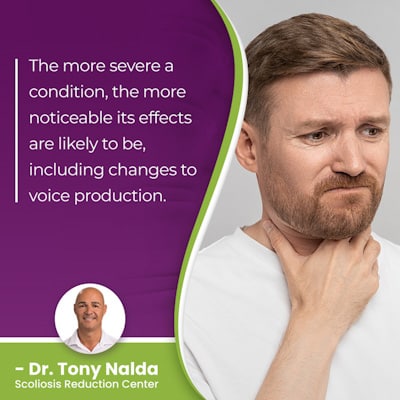Can Scoliosis Affect My Voice? Insights and Facts

Scoliosis can affect the body in a number of surprising ways. Not only does scoliosis affect the spine and its surrounding muscles and nerves, as the spinal column within works in tandem with the brain to form the central nervous system (CNS), spinal conditions like scoliosis can also affect general brain-body communication.
Although scoliosis is a structural spinal condition, its effects can be widespread. One of the main effects of scoliosis is postural changes, and as posture regulates breathing, and breathing is a key part of speaking/singing, a person's voice can be affected by scoliosis: more common in cases of severe scoliosis.
As the main effect of scoliosis in children is postural changes, and this is the underlying cause of related voice changes, let's start with how scoliosis can cause postural changes.
Table of Contents
The Effects of Scoliosis
As mentioned, scoliosis can affect the body in a number of ways.
The spine gives us structure, allows us to stand upright and practice good posture, and engage in flexible movement, and as the central nervous system, the brain and spinal column are involved in the function of virtually every part and system at work within the body.
Scoliosis involves the development of an abnormal curvature and rotation of the spine (sideways-bending and twisting), and as a progressive condition, the effects of scoliosis are known to become more overt over time as the condition gets worse.
 Scoliosis introduces a lot of uneven forces to the body, and they can disrupt the body's overall symmetry, presenting as postural deviation.
Scoliosis introduces a lot of uneven forces to the body, and they can disrupt the body's overall symmetry, presenting as postural deviation.
Scoliosis isn't commonly painful in children because the condition doesn't become compressive until skeletal maturity has been reached; in children, the constant lengthening motion of a growing spine counteracts the compressive force of the unnatural spinal curve.
It's compression (uneven pressure) of the spine and its surrounding muscles and nerves that causes the majority of condition-related pain, and in adults, the main effect of scoliosis is pain; it's pain that brings the majority of my adult patients in for a diagnosis and treatment.
In children, postural deviation is the most noticeable effect, and in most cases, the condition's early signs are uneven shoulders and uneven hips.
In addition, these postural changes can also occur:
- Uneven shoulder blades
- The development of a rib cage arch
- An uneven waistline
- Arms and legs that appear to hang at different lengths
As a result of the body's shifting center of gravity and related postural changes, changes to gait, balance and coordination are also common, in addition to clothing that suddenly seems ill-fitting.
Scoliosis severity ranges from mild scoliosis to moderate scoliosis to severe and very severe scoliosis; no two cases will be exactly the same.
The more severe a condition, the more noticeable its effects are likely to be, including changes to voice production.
Most often, I diagnose scoliosis in adolescents as adolescent idiopathic scoliosis, diagnosed between the ages of 10 and 18, and this is the most common type of scoliosis overall, and scoliosis screening in children can involve a combined physical examination that includes an Adam's forward bend test.
If a screening exam finds condition indicators, I order a scoliosis X-ray to truly see what's happening in and around the spine, to confirm a patient's Cobb angle measurement, and reach an official diagnosis of scoliosis.
So in context of the postural changes that can accompany scoliosis progression, let's consider the vocal tract, where it's located, and how symptoms of scoliosis can affect a person's ability to inhale/exhale deeply.
Scoliosis and Lung Impairment
While scoliosis can cause a number of different effects felt throughout the body, lung impairment isn't considered a common effect of scoliosis, but it can be a related complication, particularly in cases of severe scoliosis and/or when higher-than-average demands are placed on the respiratory system.
When scoliosis progresses, a related postural effect is the development of a rib cage arch, and this is particularly common in cases of thoracic scoliosis.
Scoliosis can develop in any of the spine's three main sections, but the thoracic spine, as the largest spinal section, is the most commonly affected.
When an unnatural spinal deformity in the middle/upper back is pulling on the rib cage, it can cause a disruption in the space available for the lungs to function within.
If the lungs are compressed, it can be difficult to continue breathing normally and rhythmically during periods of exertion.
If it's difficult to breathe deeply, this can get worse as the condition progresses, and as mentioned, this is most likely to affect patients with severe or very severe scoliosis, and people like professional athletes and singers who need their lungs to function optimally.
A typical scoliosis patient who doesn't place any extra demands on their respiratory system is unlikely to notice whether lung impairment is an effect or not.
So now let's focus on lung function, voice production, and scoliosis.
Scoliosis and Voice
 If you've ever tried to project your voice and enunciate clearly while sitting slumped over or twisting awkwardly to the side, you'll have noticed that posture is important; in fact, when it comes to voice production and singing, it's key.
If you've ever tried to project your voice and enunciate clearly while sitting slumped over or twisting awkwardly to the side, you'll have noticed that posture is important; in fact, when it comes to voice production and singing, it's key.
The vocal tract is the area of the body where sound is produced and filtered, and the lungs supply it with air to inhale and exhale deeply as needed.
When it comes to average speaking, a person is unlikely to find their scoliosis causes an overly-noticeable change, but when it comes to projecting one's voice in public speaking, singing, and particularly professional singing, if a person with severe scoliosis is experiencing lung impairment, it can affect the ability of the lungs and voice box to function optimally.
And the related postural changes that can cause a loss of space within the chest cavity for the lungs to perform optimally within can also contribute to changing a person's voice.
Forward head posture is a common related complication of scoliosis, and this can develop as an unnatural curve in the thoracic and/or cervical spine causes the head to shift forward, increasing its weight on the cervical spine and effecting the range of motion in the neck.
Scoliosis is also known to cause a muscle imbalance as the unnaturally-curved spine pulls its surrounding muscles in different directions, and there is a link between muscle length-tension and postural alignment.
Conclusion
So can scoliosis affect my voice? To be clear, a person's voice changing isn't a common effect of mild and moderate scoliosis, but when/if a patient's scoliosis is left untreated, isn't treated proactively, and/or becomes severe, scoliosis effects can become more widespread, including potential voice changes.
As a progressive condition, where a scoliosis is at the time of diagnosis doesn't mean that's where it will stay, and as scoliosis progresses, the size of the unnatural scoliotic curve is increasing, as are the condition's uneven forces, and their effects.
The more a patient's posture is disrupted, the more likely it is that related complications such as lung impairment and voice changes are possible; however, it's also important to understand that as such a highly-variable and complex spinal condition, what one patient experiences doesn't always reflect what others will face.
When it comes to the management of scoliosis, this means treatment, and when it comes to progressive conditions like scoliosis, while I can never guarantee treatment success, early detection and intervention is associated with treatment success.
The best way to minimize the effects of scoliosis is to prevent them from getting worse, and that means working proactively towards preventing progression, increasing condition effects, and the need for invasive spine surgery in the future.
Spinal fusion is a common response of traditional scoliosis treatment, but the reality is that many cases of scoliosis don't require surgical intervention.
Here at the Scoliosis Reduction Center, my patients benefit from a proactive conservative treatment approach that combines multiple condition-specific treatment disciplines so conditions can be impacted on every level.
Through chiropractic care, I can impact conditions structurally in the form of a curvature reduction, and through physical therapy and the prescription of scoliosis-specific exercises (SSEs), I can address postural issues such as forward head posture, any related muscle imbalance, and increase core strength so the spine's surrounding muscles can optimally support and stabilize it.
Corrective bracing can be particularly helpful when treating scoliosis in young patients whose spines are still growing, and this can help by pushing the spine into a corrective position.
Rehabilitation means further healing and stabilizing the spine through the application of scoliosis-specific exercises and stretches patients can easily perform from home.
With treatment success, scoliosis effects can be managed, minimized, and oftentimes, eliminated.
Dr. Tony Nalda
DOCTOR OF CHIROPRACTIC
After receiving an undergraduate degree in psychology and his Doctorate of Chiropractic from Life University, Dr. Nalda settled in Celebration, Florida and proceeded to build one of Central Florida’s most successful chiropractic clinics.
His experience with patients suffering from scoliosis, and the confusion and frustration they faced, led him to seek a specialty in scoliosis care. In 2006 he completed his Intensive Care Certification from CLEAR Institute, a leading scoliosis educational and certification center.
About Dr. Tony Nalda
 Ready to explore scoliosis treatment? Contact Us Now
Ready to explore scoliosis treatment? Contact Us Now





